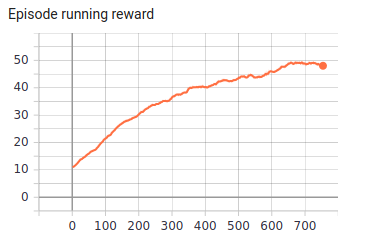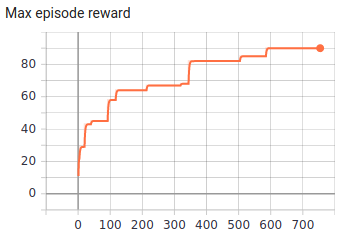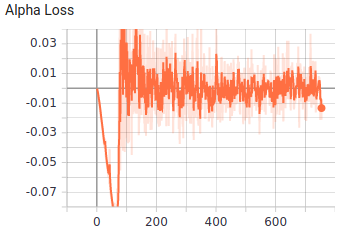This repository is a PyTorch implementation of the Discrete SAC on MsPacmanNoFrameskip-v4 environment.
Soft Actor-Critic Algorithms and Applications is known to be the state-of-the-art reinforcement algorithm for continuous action settings, however to make it applicable for discrete action settings, some modifications should be carried on its derivation:
| Continuous SAC | Discrete SAC |
|---|---|
 |
 |
 |
 |
 |
 |
| Non-Greedy Stochastic Action Selection | Greedy Action Selection |
|---|---|
 |
 |
x-axis: episode number.
 |
 |
 |
|---|---|---|
 |
 |
 |
All values are based on the original paper.
| Parameters | Value |
|---|---|
| lr | 3e-4 |
| batch_size | 64 |
| gamma | 0.99 |
| initial_random_steps | 20000 |
| train_period (number of steps between each optimization) | 4 |
| fixed_network_update_freq | 8000 |
- gym == 0.17.3
- numpy == 1.19.2
- opencv_contrib_python == 4.4.0.44
- psutil == 5.5.1
- torch == 1.6.0
pip3 install -r requirements.txtmain.py [-h] [--mem_size MEM_SIZE] [--env_name ENV_NAME]
[--interval INTERVAL] [--do_train] [--train_from_scratch]
[--do_intro_env]
Variable parameters based on the configuration of the machine or user's choice
optional arguments:
-h, --help show this help message and exit
--mem_size MEM_SIZE The memory size.
--env_name ENV_NAME Name of the environment.
--interval INTERVAL The interval specifies how often different parameters
should be saved and printed, counted by episodes.
--do_train The flag determines whether to train the agent or play
with it.
--train_from_scratch The flag determines whether to train from scratch or
continue previous tries.
--do_intro_env Only introduce the environment then close the program.- In order to train the agent with default arguments , execute the following command and use
--do_trainflag, otherwise the agent would be tested (You may change the memory capacity and the environment based on your desire.):
python3 main.py --mem_size=135000 --env_name="MsPacmanNoFrameskip-v4" --interval=100 --do_train- If you want to keep training your previous run, execute the followoing:
python3 main.py --mem_size=135000 --env_name="MsPacmanNoFrameskip-v4" --interval=100 --do_train --train_from_scratch- The whole training procedure was done on Google Colab and it took less than an hour of training, thus a machine with similar configuration would be sufficient.
├── Brain
│ ├── agent.py
│ └── model.py
├── Common
│ ├── config.py
│ ├── logger.py
│ ├── play.py
│ └── utils.py
├── demo
│ ├── greedy.gif
│ └── non-greedy.gif
├── equations
│ ├── continuous_alpha.png
│ ├── continuous_policy.png
│ ├── continuous_v.png
│ ├── discrete_alpha.png
│ ├── discrete_policy.png
│ └── discrete_v.png
├── main.py
├── Memory
│ └── replay_memory.py
├── models
│ └── 2020-12-07-14-38-22
│ └── params.pth
├── __pycache__
├── README.md
├── requirements.txt
└── results
├── alpha_loss.png
├── alpha.png
├── max_episode_reward.png
├── policy_loss.png
├── q_loss.png
└── running_reward.png- Brain dir consists the neural network structure and the agent decision making core.
- Common consists minor codes that are common for most RL codes and do auxiliary tasks like: logging, wrapping Atari environments and... .
- main.py is the core module of the code that manges all other parts and make the agent interact with the environment.
- Memory consists memory of the agent.
- Soft Actor-Critic For Discrete Action Settings, Christodoulou, 2019
- Soft Actor-Critic Algorithms and Applications, Haarnoja et al., 2018
- Big thanks to the author of the reference paper and the publisher of the original code, @p-christ.
- The @ku2482's code, sac-discrete.pytorch is a great guide to implement the Discrete SAC algorithm.
